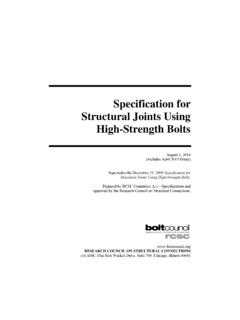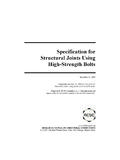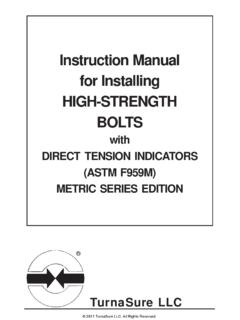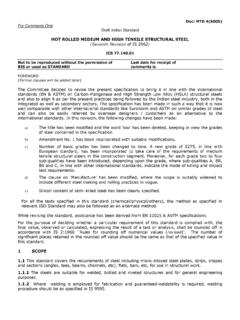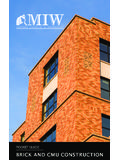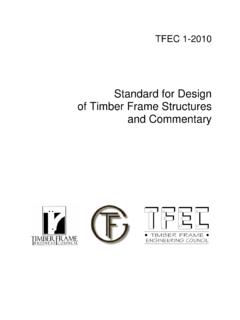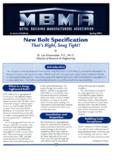Transcription of The specification, design and construction of …
1 The specification , design andconstruction of drainage andsewerage systems usingvitrified clay pipesThe specification , design and construction of drainage and sewerage systems using vitrified clay pipes Foreword using updated material previously published within a range of smaller CPDA booklets, this guide provides a one-stop source for the bulk of information needed for the specification , design and construction of drains and sewers using vitrified clay pipes. Where a greater depth of information is required from structural design or flow tables 1 or on the subject of hydrogen sulphide in sewers 2, copies ofthe original booklets are currently still available. Introduction On 1st November 1991 a new British and European standard, BS EN 295 3, was published to replace BS 65:1988 for flexibly jointed vitrified clay pipes and fittings, with or without sockets, for the construction of drainage and sewerage systems.
2 The same European standard, EN 295, is used in all the 18 countries of CEN, the European Committee for Standardisation, prefixed by the appropriate National standards organisation identifier, such as BS in Britain, DIN in Germany, or AE in Spain. EN 295 was the first European pipe standard. The design and construction of sewers and drains in the United Kingdom has been largely controlled over recent years by the provisions of BS 8005 5, the Guide to new sewerage construction , and BS 8301 6, the Code of practice for building drainage. The other principal reference documents in these fields are the Civil Engineering specification for the Water Industry 7, Sewers for Adoption 8, the Scottish Standard specification for Water and Sewerage Schemes 9 and Approved Document H to the Building Regulations 10, together with the equivalent building regulations documents for Scotland 11 and Northern Ireland 12 These documents are generally based on the material in BS 8005 5 and BS 8301 6.
3 The publication during 1997 and 1998 of new European standards covering the design and construction of drains and sewers has changed this picture. The standards are BS EN 752 - Drain and sewer systems outside buildings 13, BS EN 1295-1 -Structural design of buried pipelines under various conditions of loading 14 and BS EN 161 O - construction and testing of drains and sewers 15. They have become the references to be used in specification documents and with this, some of the procedures to be adopted have been changed, although not as many as might be imagined. Each standard sets out basic provisions, common to all user countries, and provides annexes giving additional information by referencing for each country existing National standards, codes and guides, such as those referred to earlier, together with other relevant technical information. In areas where existing National methods needed to be retained, specific National annexes are provided to the standards.
4 For British standards, these National annexes largely contain the familiar information from BS 8005 and BS 8301, brought up to date where necessary. In this way, most pre existing design and construction practices will not need to change with the advent of the European standards. Two exceptions to this are in revised design methods for flow prediction in BS EN 752-4 and pipeline testing procedures in BS EN 1610. Scope of this document In the following pages, the way in which the normal range of planning, design and construction issues for drains and sewers are dealt with by the current European standards is outlined. Bracketed references are given throughout the text to the relevant standard and clause number. Each National annex clause is designated by the letter N and a main subject letter, followed by a sub-clause number. Thus, BS EN 752-3 is the unique reference for the National annex section on rodding eyes in BS EN 752 part 3.
5 This document is not designed to replace the advice given in the standards, to which reference should be made for detailed guidance. Materials General (BS EN 752-3 ) Materials for pipes, pipe joints, pipe bedding, fittings, inspection chambers, manholes and associated works should be selected to ensure satisfactory service for the life of the drainage or sewerage system. Factors to be taken into account include:-(a)The nature of the effluent and the possibilityof chemical attack.(b)The possibility of mechanical attack fromcleansing processes such as jetting, orrodents.(c)The nature of the ground and the possibilityof subsidence or chemical attack.(d)The physical and chemical characteristics ofthe materials.(e)The expected quality of workmanship.( f) The degree of supervision to be provided. Resistance to chemical attack (BS EN 752-3 ) Pipes and joints in the materials shown in the following list are generally considered to be suitable for sewers and drains conveying effluents that may legally be discharged to public sewers.
6 Specific material limitations need to be considered if they are to be laid in ground that may be corrosive or used to carry corrosive effluents, particularly at elevated temperatures, or where septicity may develop. Clay as a material Clay pipes are resistant to chemicals within the pH range 3-11. They are not subject to attack by sulphuric acid produced where septic sewage conditions give rise to the production of hydrogen sulphide and can carry a wide range of aggressive effluents. They can be laid in aggressive ground conditions without damage, such as where sulphates are present. Selected products can cover the wider pH range of 2-12. Extra chemically resistant pipes and joints are also available. Clay pipes resist mechanical cleaning methods, such as rodding and winching because of their high strength and durability. They are also impervious to rodent attack. Recent research conducted by WRc recognised that high jetting pressures are used by pipeline cleaning contractors, especially when clearing blockages.
7 Clay pipes are resistant to pressures in excess of the 5,000 psi subsequently shown as the highest acceptable pressure in the WRc code of practice on jetting 16, produced after the research programme. British and European Standards for pipe materials and associated items Vitrified Clay BS EN 295 & BS 65 Concrete BS 5911 (prEN 1916) Polyethylene BS 6437, CP 312 Polypropylene BS EN 1852-1 Cast Iron ISO 694 (prEN 877) PVC-U BS EN 1401 Ductile Iron BS EN 598 GRP BS 5480 Plastic manholes BS 7158 Manhole covers and gully gratings for roads Bedding materials for pipes BS EN 124 BS EN 1610, The specification of clay pipes to BS EN 295 1-7 BS EN 295 Part 1 specifies the requirements for appropriate dimensions, tolerances and performance of flexibly jointed pipes, fittings and joints for drains and sewers. Two amendments to this part of the standard have so far been published, which have principally increased the available range of pipe strengths and jointing systems.
8 It is supported by BS EN 295 Part 2, which specifies the quality control and sampling requirements for the manufacturer's internal quality control procedures, third party assessment and inspection. BS EN 295 Part 3 specifies the test methods used to verify compliance with the requirements specified in BS EN 295 Part 1 . 2 BS EN 295 Part 4 was published in September 1995 and covers the requirements for special fittings, adaptors and compatible accessories. These include repair couplings, which are used to repair existing pipelines, to make post connections to pipelines by inserting purpose made junctions or to connect pipes of different materials or outside diameters. They are required to have the same joint performance as the joints specified in BS EN 295-1 fbr internal pressure, angular deflection and shear resistance. The requirements for perforated pipes are covered in BS EN 295 Part 5, published in August 1994.
9 Perforated pipes are used for the construction of french drains, land drains and the drainage of waste tips. The same basic specification requirements apply as for pipes to BS EN 295 Part 1, except that joints are not required to be watertight and the size and distribution of the perforations are specified. The requirements for vitrified clay manholes and inspection chambers are specified in BS EN 295 Part 6, published in April 1996. The last part of the standard, BS EN 295 Part 7, also published in April 1996, gives the requirements for pipes used for pipe jacking. The dimensional requirements are more stringent than those in BS EN 295 Part 1, particularly in respect of squareness of pipe ends, straightness of pipe barrel and tolerances on outside diameter. The method for obtaining the compressive strength and the maximum jacking force are given. A revised version of BS 65 4 was also published in 1991, covering the specification of items which were not within the scope of the European standard.
10 These are pipes, fittings and flexible joints for surface water applications, extra chemically resistant pipes and ducts. Definitions Important definitions provided by the standard (BS EN 295-1 ) include:-Nominal size (DN) - A numerical designation of size which is a convenient round number equal to or approximately equal to the bore in millimetres; Curvature - The angle subtended by the length of a curved fitting at the centre of a circle of nominal radius through the centreline of the fitting; Joint assembly - The adjacent ends of pipes, fittings or adaptors and the means of joining them. Materials Pipes and fittings are required to be made from suitable clays and be properly fired to vitrification (BS EN 295-1 ). Visual imperfections are permitted, provided that the major performance characteristics of pipes, such as durability, impermeability and flow, are unaffected. Pipes and fittings may be unglazed or glazed and the glaze may be on either their interior or exterior surfaces, or on both.
